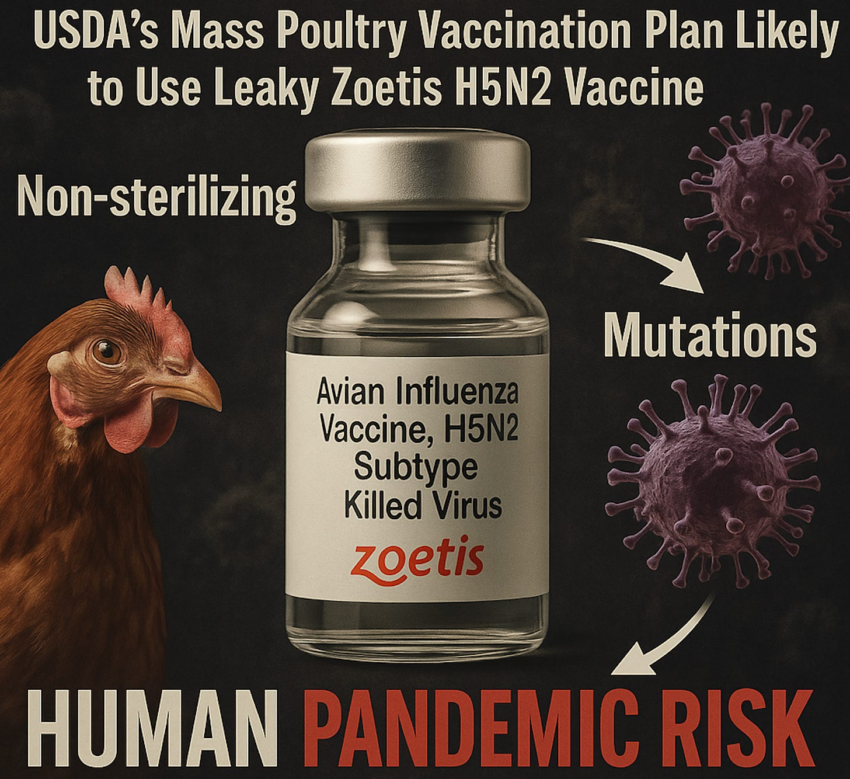The USDA is preparing to authorize mass vaccination of chickens against H5N1 bird flu:
The leading candidate appears to be the Zoetis vaccine targeting H5N2 — even though the dominant strain spreading through U.S. flocks is H5N1 clade 2.3.4.4b.
The vaccine uses the N2 neuraminidase subtype deliberately to support DIVA (Differentiating Infected from Vaccinated Animals) surveillance — allowing authorities to detect field infections in vaccinated birds.
In February 2025, the USDA issued a conditional license to Zoetis for its Avian Influenza Vaccine, H5N2 Subtype, Killed Virus, specifically for use in chickens, based on a “reasonable expectation of efficacy based on serology data”. In other words, the approval rests on hope that antibody titers will translate into real-world protection—not on demonstrated effectiveness against infection or transmission.
A conditional license allows the vaccine to be used immediately, but only under specific circumstances—such as during an outbreak or in targeted populations. As of June 2025, Zoetis’s H5N2 vaccine remains the only avian influenza vaccine conditionally approved by the USDA for use in U.S. poultry. No other vaccines are currently authorized or ready for large-scale deployment.
However, according to the USDA, inactivated virus vaccines—such as the Zoetis H5N2 formulation—are non-sterilizing in the field. This means they do not prevent infection, do not eliminate viral shedding, and allow vaccinated birds to silently carry and transmit H5N1, particularly in densely populated commercial flocks.
This partial immunity places evolutionary pressure on the virus, increasing the likelihood of highly infectious or lethal immune escape mutations and the potential for mammalian adaptation and human spillover—as discussed in my article yesterday.
A recent study by Li et al found that mass vaccination of poultry against H5N1 with a non-sterilizing vaccine during a widespread animal pandemic can accelerate viral evolution, leading to more virulent strains and increasing the risk of a human pandemic:
Read et al found that imperfect vaccination can enhance the transmission of highly virulent pathogens, showing that leaky vaccines in poultry enabled the survival and spread of hyper-pathogenic Marek’s disease virus strains.
Recent headlines have spotlighted five human deaths from H5N1 in Cambodia this year in individuals who have had close contact with dead or sickened poultry. These are real and tragic losses — but also not directly relevant to the U.S. outbreak.
The strain involved in these cases is clade 2.3.2.1c—a long-endemic variant in Cambodia that is distinct from clade 2.3.4.4b, the strain currently circulating in North America.
The Bio-Pharmaceutical Complex may use these deaths to emotionally justify the dangerous mass poultry vaccination plan.
Epidemiologist and Foundation Administrator, McCullough Foundation
www.mcculloughfnd.org
Please consider following both the McCullough Foundation and my personal account on X (formerly Twitter) for further content.
Click this link for the original source of this article.
Author: Nicolas Hulscher, MPH
This content is courtesy of, and owned and copyrighted by, https://petermcculloughmd.substack.com and its author. This content is made available by use of the public RSS feed offered by the host site and is used for educational purposes only. If you are the author or represent the host site and would like this content removed now and in the future, please contact USSANews.com using the email address in the Contact page found in the website menu.














